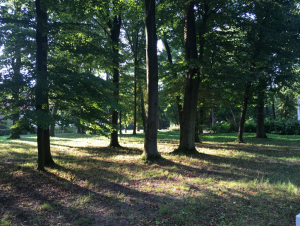By Paul Kieniewicz
I live in an ancient forest, and often wonder about the relationships between the trees. For the past 80 years nobody interfered with the forest’s growth. No large trees were removed, there was no pest control or forest management. One result was that the forest developed a dense growth with trees close together. Many grew tall and elongated and had poorly developed crowns. Foresters who visited us all shook their heads and declared that the forest was all wrong. We need to thin it out, cut out the smaller trees so that the larger trees would have more space and develop a proper crown. They also said that we’re waiting for trouble. Our lanky trees are unwieldy and will be vulnerable in a wind storm.
 Countering the foresters’ advice is the philosophy of Peter Wohlleben, the German forester whose “The Hidden Life of Trees” has become an international bestseller. Wohlleben views the forest as a single organism in which the trees communicate with each other and care for each other’s welfare. His approach to our problem would be through minimal interference. He believes that trees share information through emitting various gases, through their entangled root systems, and in large part via a fungal network that is well developed in most forests, often called the “wood-wide web”. Unlike in the world of mammals, where survival of the fittest is often the chief modality of life, trees cooperate with each other, take care of weaker trees of their own species, often helping those to resist insect attacks. Where the growth is dense, such as in our forest, the trees grow stronger by putting on extra growth to gain height rather than girth. Their crowns rarely interfere with each other. In some trees the branches feel the presence of other trees and maintain a space between their crowns. Dead trees that are left standing become fodder for insects and fungi that otherwise would attack healthy trees. For that reason, they should be left in place and not removed. Though dead and decaying, they are helping the forest.When and how trees develop blossoms and fruit is a mystery I’ve often pondered. In some years beech trees produce a great harvest of nuts, other year very little. Some ash trees bloom in early April, others a couple of weeks later. Just what is going on? Wohlleben suggests that it’s all about what is good for the forest as a whole. Producing fruit takes a lot of energy, and so does fending off an insect attack. By staggering their blossom calendar, the forest ensures that at least some trees will
Countering the foresters’ advice is the philosophy of Peter Wohlleben, the German forester whose “The Hidden Life of Trees” has become an international bestseller. Wohlleben views the forest as a single organism in which the trees communicate with each other and care for each other’s welfare. His approach to our problem would be through minimal interference. He believes that trees share information through emitting various gases, through their entangled root systems, and in large part via a fungal network that is well developed in most forests, often called the “wood-wide web”. Unlike in the world of mammals, where survival of the fittest is often the chief modality of life, trees cooperate with each other, take care of weaker trees of their own species, often helping those to resist insect attacks. Where the growth is dense, such as in our forest, the trees grow stronger by putting on extra growth to gain height rather than girth. Their crowns rarely interfere with each other. In some trees the branches feel the presence of other trees and maintain a space between their crowns. Dead trees that are left standing become fodder for insects and fungi that otherwise would attack healthy trees. For that reason, they should be left in place and not removed. Though dead and decaying, they are helping the forest.When and how trees develop blossoms and fruit is a mystery I’ve often pondered. In some years beech trees produce a great harvest of nuts, other year very little. Some ash trees bloom in early April, others a couple of weeks later. Just what is going on? Wohlleben suggests that it’s all about what is good for the forest as a whole. Producing fruit takes a lot of energy, and so does fending off an insect attack. By staggering their blossom calendar, the forest ensures that at least some trees will produce viable seeds for the next generation, even though they may not be able to fend off an insect attack Each species that produces fruit tries to ensure that the seed will sprout, rather than be fodder for the boar. Seed falling on frozen ground won’t sprout. The Rowan tree adopts another strategy of letting their seeds lie for years before sprouting. That way, the young sprouts do not become instant fodder for deer.
produce viable seeds for the next generation, even though they may not be able to fend off an insect attack Each species that produces fruit tries to ensure that the seed will sprout, rather than be fodder for the boar. Seed falling on frozen ground won’t sprout. The Rowan tree adopts another strategy of letting their seeds lie for years before sprouting. That way, the young sprouts do not become instant fodder for deer.
Wohlleben’s book left me looking at the forest differently. Perhaps his view of trees is too anthropomorphic. He talks about trees having feelings, such as love, caring. Willow trees are loners. Perhaps there are good guys and bad guys. I’m not sure about that aspect. However, his vision of the forest as primarily an intelligent organism appears to be borne out by research. It makes one think more than once about taking the axe to a tree, because we believe that we can do better in managing a forest than the forest does itself.
